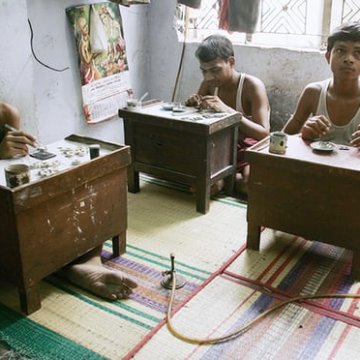- About
- Topics
- Picks
- Audio
- Story
- In-Depth
- Opinion
- News
- Donate
- Signup for our newsletterOur Editors' Best Picks.Send
Read, Debate: Engage.
| located: | India, United Kingdom, USA, Pakistan |
|---|---|
| editor: | Gurmeet Singh |
Rumbling around the vast belly of the internet is the undigested statistic that 11% of the world's gold is owned by Indian housewives. There's of course no way of knowing whether this is true or not, but nevertheless, commentators have transformed this estimate into a fact; such is the power of an online statistic.
A more substantial fact is to say that India is obsessed with gold. Gold imports have risen year on year since the early 2000s, and the only time gold purchasing fell below its regular phenomenal sales rate was during the 2016-2017 cash crisis, which saw middle class Indians unable to withdraw cash due to the government's poor cash handling.
Gold is an inviolable symbol of the Indian good life. There may be no single analogue in the west: a good job, a nice car, a big house, club memberships, money — all single elements in the western good life, but none of them as singular and all-encompassing as gold is for Indians. Perhaps tulips in 17th Century Amsterdam or high-quality mushrooms in Japan can act as suitable analogues.
With such a high value placed on gold and jewellery in India, it's no surprise that smaller, parasitic markets thrive on the back of the mammoth. These include markets for fake gold, fake jewellery and a black market for stolen objects. These may seem like the innocuous and expected consequences of such a popular market, but they belie much darker truths.
70 children have recently been saved from an imitation gold jewellery factory in Gujarat, a west coast state in India. The jewellery was due to be sold in the U.K., U.S. and European markets. Had not two children run away from the factory to alert the police, it surely would have been way on its way to those markets. According to The Guardian, "Questioning of employers and the children was in turn revealing other workshops that employ children in the nearly £109m industry with which Rajkot has become synonymous."
Detection of children in supply chains is difficult, especially in industries and countries where work is informal and outsourced. Nevertheless, the government and police hope to save more children from a lifelong sentence to slavery in the manufacture of cheap ornaments. Gold industries, like the diamond ones, may have to start doing much more to show how and where their objects come from.
Image: Children working in an imitation jewellery factory, Photograph: Manan Vatsyayana/AFP/Getty Images
